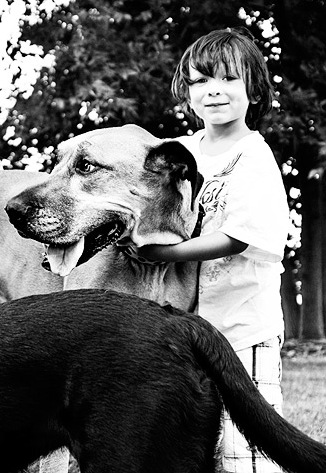 The Great Dane is a dog that seems to capture attention wherever it goes, stopping traffic and drawing crowds. When well-bred, this dog is tall, chiseled and muscular in form, with a regal bearing. The qualities and characteristics of a well-bred Great Dane reflect the hundreds of years of careful breeding that has gone into the making of this magnificent creature. With popular media being what it is, as well as the legend and lore that accompanies the Great Dane, sometimes it can be difficult to know what is true and what is false when it comes to this huge breed of dog. Here are 10 Things You Might Not Know about the Great Dane:
The Great Dane is a dog that seems to capture attention wherever it goes, stopping traffic and drawing crowds. When well-bred, this dog is tall, chiseled and muscular in form, with a regal bearing. The qualities and characteristics of a well-bred Great Dane reflect the hundreds of years of careful breeding that has gone into the making of this magnificent creature. With popular media being what it is, as well as the legend and lore that accompanies the Great Dane, sometimes it can be difficult to know what is true and what is false when it comes to this huge breed of dog. Here are 10 Things You Might Not Know about the Great Dane:
10. Apartment life is just fine for Great Danes. Despite their size, according to the AKC, life in an apartment can suit a Great Dane quite well. They are not as high energy as other breeds, but despite their couch potato ways, daily exercise is important. A brisk half hour walk a day will do, especially if complemented with some run time at a dog park or secure area a few times a week. No fenced area? A 50-foot training leash and a ball can help your Dane keep fit.
9. Great Danes grow incredibly fast. Within a span of just 1 year, Great Danes go from just a handful of fluffy puppy to being able to stand up on their hind legs and look a 6-foot tall man eye-to-eye. During their rapid growth spurts, puppies can be visibly bigger after a night’s sleep.
8. They really don’t eat that much. A full grown Great Dane eats about 2-3 cups of dry dog food in a meal. Too much protein should be avoided, particularly with puppies, as growing faster than they already do can damage bones and joints. Rather than the high-protein, quick-grow type puppy foods, they should have an adult food with no more than 23 percent protein.
7. Great Danes can be remarkably gentle. That is, once the period of rapid growth passes and they gain full control of their body, bringing an end to accidental injuries due to clumsiness. Many Danes share their homes with small dogs and cats. Great Danes have a well-deserved reputation for being wonderful with children and sometimes work as therapy dogs.
|
The Great Dane is a dog that seems to capture attention wherever it goes, stopping traffic and drawing crowds.
|
6. They must have people. Great Danes are an extremely sensitive breed and do not fare well without close contact with their human family. Living outside in a doghouse can destroy a Great Dane, make him mentally unstable, depressed, and even aggressive.
5. Anxiety can kill Great Danes. There is increasing evidence that bloat, a condition in which the stomach gets air in it and twists, or torsion, is related to anxiety. This can kill a Great Dane in less than an hour. Make sure to learn the symptoms and, if considering this breed, consider how much time per day the dog will have to be alone.
4. Great Danes do not respond well to hard correction or training methods, as they are emotionally sensitive creatures.
3. Modern breeders have worked hard to eliminate the centuries of breeding for the aggression necessary to hunt such prey as wild boar. While they’ve met with great success, poorly bred Danes can display dangerous throwback temperament traits. Not every Dane is Scooby Doo friendly. Never approach a Great Dane on the assumption of friendliness, especially if the Dane is accompanied by the children in his family, as the drive to protect the youngsters of the pack from perceived danger isn’t something that is so easily bred out.
2. They are not the tallest breed. Although the current holder of the world record for tallest dog is a 42-inch tall Great Dane, the Irish Wolfhound is the breed that tends to be tallest, though it is lighter in weight.
1. Many Great Danes are thrown away. People don’t seem to understand that Great Danes are giant, powerful dogs. One of the most common periods for this breed to be surrendered to a shelter or rescue organization is after they are 9 months old, as people neglect to factor in the potentials of a still rapidly growing 100-pound dog that, because of his age, still acts like a crazy puppy.